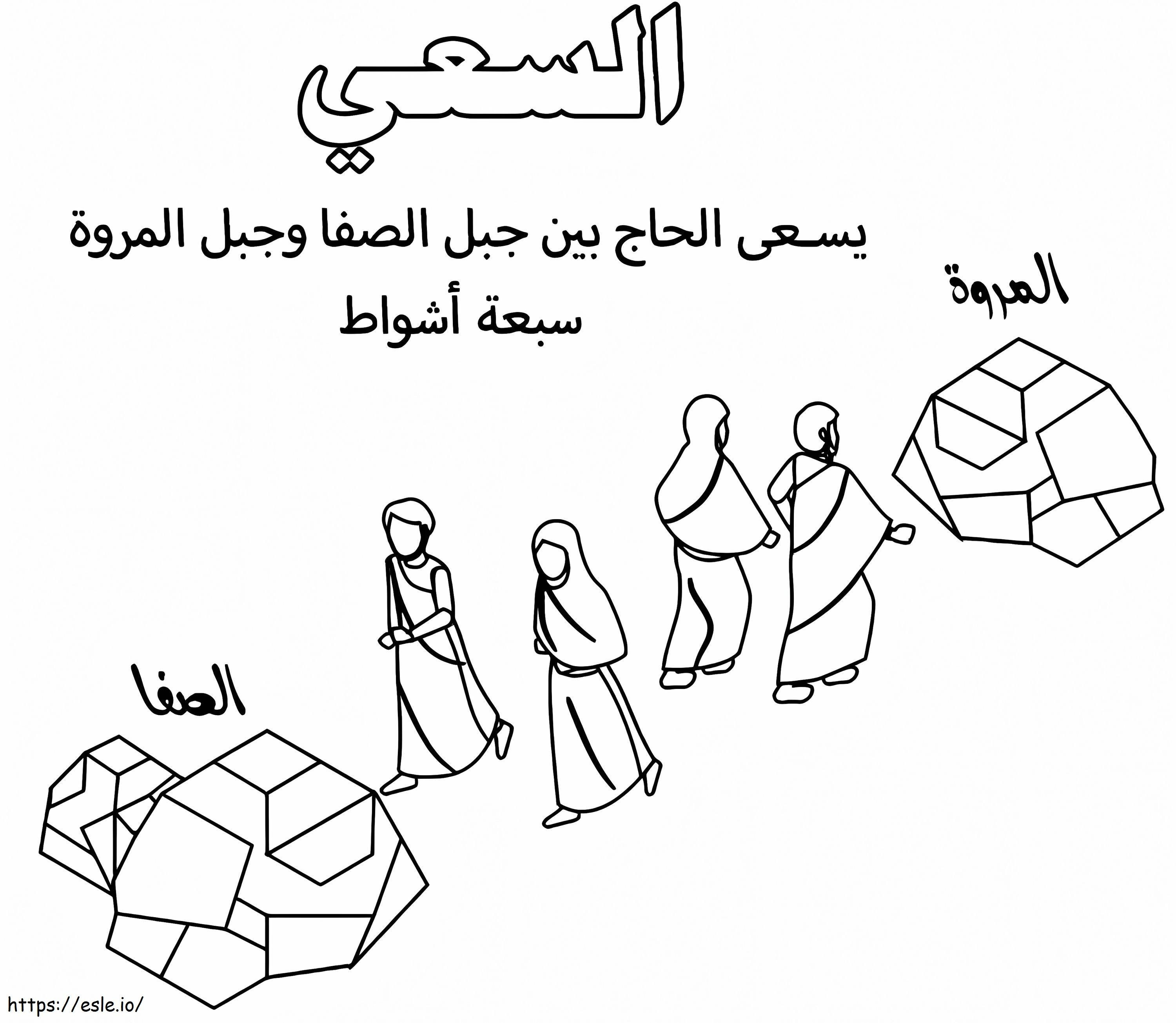Safa Marwa Distance: The Ultimate Guide To Understanding The Spiritual Journey
Have you ever wondered about the significance of Safa Marwa Distance? If you're planning to perform Hajj or Umrah, understanding this distance is crucial. It's not just about the physical journey but also the spiritual connection that millions of Muslims seek. This guide will take you through everything you need to know about the distance between Safa and Marwa, its importance, and how it fits into the rituals of Hajj and Umrah.
When people talk about Safa Marwa Distance, they’re referring to one of the most sacred pilgrimages in Islam. Walking between these two hills is more than just a ritual—it’s a testament to faith and devotion. Every step taken between Safa and Marwa carries deep spiritual meaning, connecting pilgrims to the legacy of Prophet Ibrahim (peace be upon him).
This article will break down the concept of Safa Marwa Distance, provide practical tips for pilgrims, and answer common questions. Whether you're preparing for your own pilgrimage or simply curious about this sacred journey, we've got you covered. Let's dive in!
Table of Contents
- Introduction to Safa Marwa Distance
- The Historical and Religious Background
- Exact Distance Between Safa and Marwa
- Rituals Involving Safa and Marwa
- The Spiritual Significance
- Practical Tips for Pilgrims
- Frequently Asked Questions
- Interesting Statistics
- Common Mistakes to Avoid
- Conclusion and Final Thoughts
Introduction to Safa Marwa Distance
Alright folks, let’s start with the basics. The Safa Marwa Distance is something every Muslim should know if they’re planning to perform Hajj or Umrah. It’s not just about walking between two hills; it’s a symbolic act that connects you to the past and deepens your faith. The distance itself might seem short, but the journey is immense in spiritual terms.
When we talk about Safa and Marwa, we’re referring to two small mountains located near the Grand Mosque in Mecca. These hills have been part of Islamic tradition for centuries, and they play a central role in the rituals of Hajj and Umrah. Pilgrims walk back and forth between them seven times, retracing the steps of Hajar, the wife of Prophet Ibrahim (peace be upon him).
Now, here’s the kicker—this act isn’t just about physical movement. It’s about reflection, gratitude, and understanding the struggles faced by those who came before us. So, whether you’re a first-timer or a seasoned pilgrim, knowing the distance and its significance can enhance your experience.
The Historical and Religious Background
Let’s rewind a bit and talk about the history behind Safa and Marwa. These two hills are steeped in religious significance, and their story dates back to the time of Prophet Ibrahim (peace be upon him). According to Islamic tradition, Hajar, the wife of Prophet Ibrahim, ran between Safa and Marwa in search of water for her son, Ismail.
Key Events in History
- Hajar’s desperate search for water led to the miraculous appearance of the Zamzam well.
- This act of perseverance and faith has been commemorated ever since by Muslims performing Hajj and Umrah.
- The Prophet Muhammad (peace be upon him) emphasized the importance of this ritual, making it a mandatory part of the pilgrimage.
It’s fascinating how this historical event continues to inspire millions of people today. The story of Hajar teaches us about trust in Allah, patience, and the rewards of perseverance. Every time pilgrims walk between Safa and Marwa, they’re reminded of these timeless lessons.
Exact Distance Between Safa and Marwa
So, how far exactly is the Safa Marwa Distance? Well, the distance between the two hills is approximately 450 meters (about 1,476 feet). Pilgrims are required to walk this distance seven times, covering a total of around 3.15 kilometers (nearly 2 miles). While this might not seem like a lot, remember that it’s done in the midst of a bustling crowd, often in challenging weather conditions.
Breaking It Down
- One round trip between Safa and Marwa is about 900 meters.
- Seven trips equal approximately 6.3 kilometers.
- For those with mobility issues, there are ramps and elevators available to make the journey easier.
It’s worth noting that the actual walking distance may vary slightly depending on the route taken and the flow of the crowd. Regardless, the focus remains on the spiritual aspect rather than the physical distance.
Rituals Involving Safa and Marwa
Now, let’s talk about the rituals associated with Safa and Marwa. As part of the Hajj and Umrah, pilgrims are required to perform Sa’i, which involves walking between these two hills. Here’s a step-by-step guide:
Steps to Perform Sa’i
- Begin at Mount Safa, reciting the Takbir and Talbiyah.
- Walk to Mount Marwa, maintaining a steady pace and reflecting on the story of Hajar.
- Repeat this process seven times, alternating between walking and jogging (if physically able).
- End the ritual with a final prayer at Mount Marwa.
It’s important to note that the speed and style of walking can vary. Some pilgrims choose to jog during certain segments, while others prefer a more leisurely pace. The key is to focus on the spiritual aspect rather than rushing through the ritual.
The Spiritual Significance
The Safa Marwa Distance holds immense spiritual significance for Muslims. It’s not just about completing a ritual; it’s about connecting with the past and deepening your faith. By walking between these two hills, pilgrims are reminded of Hajar’s sacrifice and the blessings of Allah.
Why It Matters
- It symbolizes trust in Allah and the importance of perseverance.
- It connects pilgrims to the legacy of Prophet Ibrahim and his family.
- It provides an opportunity for reflection and gratitude.
Many pilgrims report feeling a profound sense of peace and fulfillment after completing this ritual. It’s a reminder that our struggles, no matter how difficult, can lead to blessings beyond measure.
Practical Tips for Pilgrims
Performing Sa’i can be a challenging experience, especially with the large crowds and varying weather conditions. Here are some practical tips to help you make the most of your journey:
What to Bring
- Comfortable shoes and loose-fitting clothing.
- A water bottle to stay hydrated.
- A small bag for personal items like a prayer mat or Quran.
What to Expect
- Large crowds, especially during peak pilgrimage seasons.
- Varied walking surfaces, including ramps and stairs.
- Temperature fluctuations, so dress accordingly.
Remember, the goal is to focus on the spiritual aspect of the journey. Take your time, stay patient, and don’t hesitate to ask for help if needed.
Frequently Asked Questions
Here are some common questions about the Safa Marwa Distance:
Q: How long does it take to complete Sa’i?
A: On average, it takes about 30-45 minutes to complete the seven rounds, depending on the crowd and your pace.
Q: Can I use a wheelchair or stroller?
A: Yes, there are designated areas and ramps for those with mobility issues.
Q: Is it mandatory to jog during Sa’i?
A: No, jogging is optional and depends on your physical ability. Walking at a comfortable pace is perfectly acceptable.
Interesting Statistics
Did you know that millions of pilgrims perform Sa’i each year? Here are some fascinating statistics:
- Approximately 2 million people perform Hajj annually, with many more performing Umrah throughout the year.
- The Safa Marwa gallery can accommodate up to 30,000 pilgrims at a time.
- Modern facilities, such as air conditioning and covered walkways, have been added to enhance the experience.
These numbers highlight the importance of Safa Marwa Distance in the lives of Muslims worldwide.
Common Mistakes to Avoid
Here are some common mistakes pilgrims should avoid when performing Sa’i:
Mistakes to Watch Out For
- Rushing through the ritual without focusing on its spiritual significance.
- Forgetting to recite the necessary prayers and supplications.
- Not staying hydrated or preparing for the physical demands of the journey.
By being aware of these pitfalls, you can ensure a more meaningful and fulfilling experience.
Conclusion and Final Thoughts
In conclusion, the Safa Marwa Distance is more than just a physical journey—it’s a spiritual pilgrimage that connects millions of Muslims to their faith and heritage. Whether you’re preparing for your first Hajj or Umrah or simply curious about this sacred tradition, understanding the distance and its significance can deepen your appreciation for this remarkable ritual.
So, what’s next? If you’ve found this guide helpful, feel free to share it with others who might benefit from it. And if you have any questions or experiences to share, leave a comment below. Together, let’s continue to learn and grow in our faith!
Until next time, stay blessed and keep walking the path of righteousness!



Detail Author:
- Name : Ms. Kaitlyn Ledner
- Email : samir.lynch@bahringer.com
- Birthdate : 1985-04-07
- Address : 85397 Celestine Garden Suite 175 Feestport, VT 19805
- Phone : 985-828-9296
- Company : Hansen, Schroeder and Mosciski
- Job : Web Developer
- Bio : Dolorum temporibus sint ut et tempora. Necessitatibus consequuntur corrupti error architecto quia similique fugit. Magnam repellendus aut vero repellat voluptates corrupti ipsa eligendi.